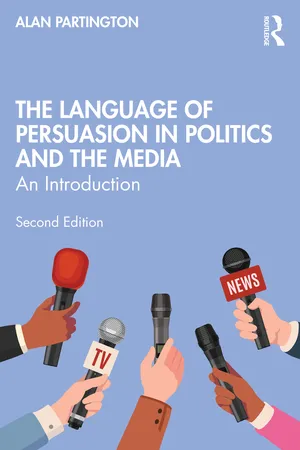
- English
- ePUB (mobile friendly)
- Available on iOS & Android
About this book
This bestselling introductory textbook examines the relationship between politicians, the press and the public through the language they employ. Now fully revised with new material on delegitimisation, 'fake news', disinformation, (self-)censorship, 'conspiracy theories' and 'Zombie' narratives, key topics include:
- Evaluation, the 'engine' of persuasion
- 'Spin', 'spin control' and 'image' politics
- Models of persuasion, including authority, contrast, problem-solution, association, 'garden path'
- Pseudo-logical and 'post-truth' arguments
- Humour, irony and satire
- Metaphors: use, misuse and dangers
- Election rhetoric
Extracts from speeches, soundbites, newspapers and blogs, social media, interviews, press conferences, election slogans and satires are used to provide the reader with the tools to discover the beliefs, character and hidden strategies of the would-be persuader, as well as the counter-strategies of their targets. This book demonstrates how the study of language use can help us appreciate, exploit and protect ourselves from the art of persuasion.
With a wide variety of practical examples, on both recent issues and historically significant ones, every topic is complemented with guiding tasks, queries and exercises, with keys and commentaries at the end of each unit. This highly original textbook is ideal for all introductory courses on language and politics, media language, rhetoric and persuasion, discourse studies and related areas.
Frequently asked questions
- Essential is ideal for learners and professionals who enjoy exploring a wide range of subjects. Access the Essential Library with 800,000+ trusted titles and best-sellers across business, personal growth, and the humanities. Includes unlimited reading time and Standard Read Aloud voice.
- Complete: Perfect for advanced learners and researchers needing full, unrestricted access. Unlock 1.4M+ books across hundreds of subjects, including academic and specialized titles. The Complete Plan also includes advanced features like Premium Read Aloud and Research Assistant.
Please note we cannot support devices running on iOS 13 and Android 7 or earlier. Learn more about using the app.
Information
Table of contents
- Cover
- Endorsements
- Half Title
- Title
- Copyright
- Contents
- List of figures and tables
- Preface
- Acknowledgements
- Unit 1: Politicians, the media and us: The language of persuasion
- Unit 2: But then along came social media …
- Unit 3: Evaluation: What’s good and what’s bad
- Unit 4: Evaluation by language choice: Selection and omission
- Unit 5: Sounding good: Rhetorical effects in action: ‘Liberté! Egalité! Fraternité!’ (But not for all …)
- Unit 6: Strategies of persuasion
- Unit 7: High-risk tactics: Fooling and insulting your audience: The Garden Path technique
- Unit 8: ‘Joined-up’ thinking: Propositional and evaluative cohesion
- Unit 9: Dirty tricks: Really? Caveat emptor!
- Unit 10: Dirty tricks? Perhaps: Dis/information wars, collusion with tyrants and conspiracy (theories)
- Unit 11: The importance of importance marking in persuasion
- Unit 12: Metaphors and company: The subtle persuaders
- Unit 13: Questions and responses: Softball questions, hardball questions and how to handle them
- Unit 14: Humour, irony and satire in politics
- Unit 15: The language of referendum campaigns
- Unit 16: The year of the six elections
- Conclusion
- Glossary
- References
- Index